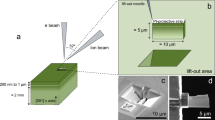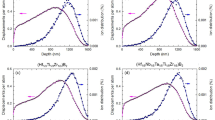Abstract
We propose here a new mechanism to explain the observed high radiation tolerance of magnesium aluminate compounds with crystal structures known as spinel. By using optical methods, we found that the kinetics of accumulation of optical absorption centers under different types of irradiation, as well as the kinetics of absorption decay after termination of irradiation, along with radio-luminescence processes, are consistent with a new model regarding defects and radiation damage in spinel. This model assumes the existence of spatially-correlated antisite defects in the form of dipoles: (Al3+tet)+-(Mg2+oct)-. These spatially-correlated point defect complexes serve as centers for annihilation of radiation-induced cation Frenkel pairs. In addition to the spatially-correlated defects, the high concentration of cation structural vacancies inherent to the spinel lattice also serves to promote high mobility of both Mg and Al interstitial species. This enhanced mobility leads to increased probability of annihilation at the dipole centers proposed in this model. Such annihilation then diminishes the probability for formation of defect clusters, dislocation loops, or amorphization of the irrradiated spinel.
Similar content being viewed by others
References
K. Fukumoto, C. Kinoshita, F.A. Garner and G.W. Hollenberg, J. Nucl. Mater. 219, 143 (1995).
A. Ibarra, F.J. Lopez and, M. Jimenez de Castro, Phys. Rev. B44, 7256 (1991).
G.P. Summers, G.S. White, K.H. Lee and J.H. Crawford, Jr., Phys. Rev. B21, 2578 (1980).
V.T. Gritsyna, I.V. Afanasye-Charkin, V.A. Kobyakov and K.E. Sickafus, J. Amer. Ceram. Soc. 82, 3365 (1999).
V.T. Gritsyna, I.V. Afanasye-Charkin, Kazarinov Yu.G. and K.E. Sickafus, in REI-12, Nucl. Instrum. and Methods in Phys. Res. B (2003) in press.
V.T. Gritsyna, Kazarinov Yu.G., V.A. Kobyakov and K.E. Sickafus, Radiat. Eff. Def. Solids 157, 659 (2002).
D.R. Wolters and J.J. van der Schoot, J. Appl. Phys. 58, 831 (1985).
A. Lushchik, M. Kirm, A. Kotlov, P. Liblik, Lushchik Ch., A. Maaroos, V. Nagirnyi, T. Savichina and G. Zimmerer, J. Luminescence 102–103, 38 (2003).
N.W. Grimes, J. Phys.: Condens. Matter 4, L567 (1992).
F. Ayres, S.S. De Sousa, A.R. Blak, Radiat. Eff. Def. Solids 156, 305 (2001).
Acknowledgments
This research was made possible in part by Award No. UE2-2226 of the U.S. Civilian Research and Development Foundation for the Independent States of the Former Soviet Union (CRDF). One of us (KES) is sponsored by the U. S. Department of Energy, Office of Basic Energy Sciences (OBES), Division of Materials Sciences and Engineering.
Author information
Authors and Affiliations
Corresponding author
Rights and permissions
About this article
Cite this article
Gritsyna, V.T., Kazarinov, Y.G., Kobyakov, V.A. et al. The Origin of Radiation Resistance of Magnesium Aluminate Spinel. MRS Online Proceedings Library 792, 359–364 (2003). https://doi.org/10.1557/PROC-792-R3.8
Published:
Issue Date:
DOI: https://doi.org/10.1557/PROC-792-R3.8




